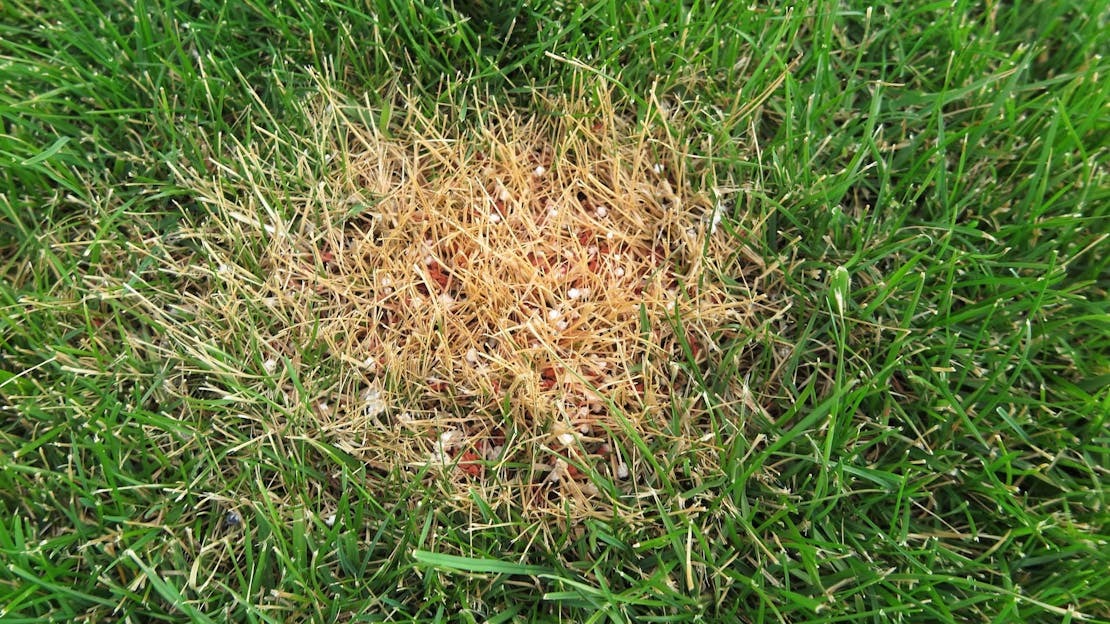
Lawn Burn
Lawn burn or scorch from fertiliser, weed killer or dog pee causes degrees of damage from yellowing of the grass to killing areas of lawn.
They are normally chemical in origin, though heat can also burn.
Lawn Fertiliser Burn
This is where the concentration of fertiliser is too high for the water in the soil to dilute. If you pour a cup of bleach on your lawn, you will kill it. However, if you put the same cup of bleach in a couple of litres of water, it will green your grass nicely.
The best way to avoid burning the lawn is to ensure there is adequate moisture in the soil, you are using the correct amount of fertiliser by weighing accurately and have an accurate measurement of the lawn area you want to feed. In addition, invest in a quality spreader; cheap spreaders or spreading by hand are unreliable and the cost of repairing the lawn outweighs the cost of a good spreader.
Powdery products have the greatest area of contact and can burn more readily. Pelleted or granular fertilisers are safer and those that are slow release such as Lawnsmith Fertilisers are the safest of all but can still burn if over applied or conditions are dry.
If you think you have fertiliser burn please go to No Scorch Fertiliser
Lawn Burn from Dog Urine
This is not a lot different from the bleach example above. You’ll notice that the lawn doesn’t burn from dog wee when it’s been raining so all you need to do is keep the dog toilet area well watered.
Lawn Burn from Weed Killer
In this case a too strong solution of weed killer has been mixed, or spraying has overlapped so some areas have had a double dose, or the grass plant is already dehydrated from lack of moisture. The grass will turn a yellow straw colour but generally in strips rather than patches.
Lawn Sand Burns Grass Easily
Lawn sand contains ferrous sulphate which is the active ingredient that kills moss. It is very aggressive and the quantity is not easily controlled so this can easily lead to grass damage. Rather than being a straw coloured burn this can blacken and shrivel the grass leaves. Even lawn care professionals can have problems with it which is why ferrous sulphate is now more commonly sprayed on the lawn.
Tools and Equipment can Burn your Lawn
Hot blowers, hedge cutters and other powered garden tools that get hot can burn the lawn leaving a straw coloured mark. Always think of this when trying to work out what has happened. Even a hot cup of tea can leave a burn disc on the lawn!
Foot shaped Burn marks in the Lawn
This is usually caused by someone who has used glyphosate and got some on their boots. This then kills the grass soon after walking across the lawn.
Some Lawn Diseases look like Burned Grass
The main one is red thread which causes straw coloured patches over the lawn from May into autumn.
What does Lawn Burn look like?
Lawn burn from chemicals or heat usually looks the same. It will be a strip, patch or patches of yellow, tan or straw coloured grass that will appear within a day or so. The greater the over dose, the quicker it will appear.
When the excess urine or fertiliser has been diluted perhaps by rain the remaining fertiliser or urine is now not strong enough to do any damage and will then start feeding the lawn giving a lush green ring around the lawn burn patch.
How can I tell if my Lawn will Grow Back or is Dead?
Water the area to flush out excess fertiliser or wee. Water every few days for about 10 days. If it’s just damaged, it will start to grow new grass, but if it’s dead, you will need to repair the area.
How to Repair Burned Grass
Simply rake out the dead area, flush with lots of water to make sure it is still not contaminated and then seed the area.